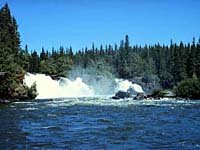
Waterbodies in Saskatchewan contain a variety of substances. One of these substances is sediment. Sediment is silt, clay and other mineral and organic material that is picked up and suspended in water moving over land and through stream and river channels. It comes from fields, forests, shorelines and stream banks and beds.

The flow of sediment is a natural process, but is greatly accelerated by many land-use activities. Water laden with sediment drops its load where the current slows, for example, at the mouths of streams and rivers. The sediment settles to the bottom, covering fish spawning habitat and suffocating incubating eggs. |
Murky water can also delay or block fish migration, confuse homing behavior, and even interfere with feeding. Fish which are largely dependent on sight (northern pike and trout) to capture prey are directly affected. Suspended sediment screens out sunlight, the source of energy for the aquatic food chain, and ultimately cuts down on the production of food for fish.
Sedimentation can also change feeding habitat. Fish that depend in insect organisms as a food source may find that their prey has died or moved on to be replace by organisms favoring silty muck bottoms. A few fish species are adapted to life in sediment-filled waters and fill in the niche no longer filled by clear-water fish. Trout cannot tolerate turbid water, in part because suspended sediment interferes with respiration and damages their gills, making them susceptible to disease and parasites.
Sediment loads increase in
- cleared areas where flows are fast and there are few obstructions to allow water to seep into the ground or sediment to settle.
- drainage channels, due to increased rate and volume of flow.
- high flow swell streams and rivers.
- from natural erosion; influenced by shoreline activities such as livestock trampling the banks of the waterbody or removing soil-holding vegetation.
- the process of road-building, where temporary crossings are improperly constructed and maintained along stream and river valleys. Ditches beside roads are often left to revegetate on their own. As a result, the areas are exposed to wind and rain, they erode and release sediment into the water for several growing seasons.
- streams and watercourses that are straightened. This action increases flow rates. Dredging the straightened waterway in order to clear the channel contributes to even more sediment.